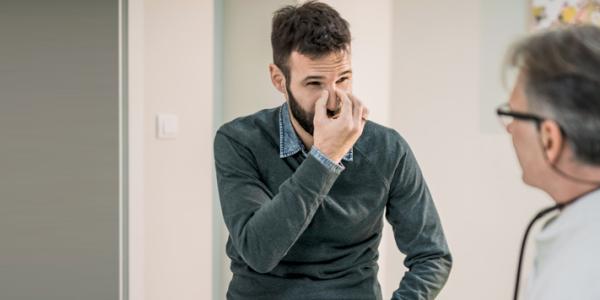Sinus conditions affect about one in eight adults in the United States and they can be miserable.
Sinuses are small air pockets that are connected to your nasal cavity. Unfortunately, when these small pockets get inflamed or swollen, they can cause big problems. Factors that contribute to sinus problems can include the structure of your air passages, allergies, environmental irritants, immune issues and more.
Sinus Infections
Sinus infections develop when fluid is trapped in your sinuses, allowing bacteria or viruses to grow. Most sinus infections are caused by viruses, not bacteria, and do not require antibiotics.
Symptoms of a sinus infection can include:
- Stuffy nose
- Thick yellow or green drainage from your nose or down the back of your throat
- Pain (and sometimes mild swelling) around your eyes, nose, cheek bones and ears
- Headache
- Aching upper teeth
- Fever
- Tiredness
Acute Rhinosinusitis
The fancy term for a sinus infection that lasts less than four weeks is acute rhinosinusitis. Most of the time, acute sinusitis clears up on its own within 10 days. You may get some comfort using saline nose rinses or over-the-counter medicine to ease symptoms. If it doesn’t improve within a couple weeks, you should see your doctor to check if further treatment is needed.
Chronic Rhinosinusitis
The symptoms of chronic sinusitis are virtually the same as acute sinusitis, but they last for more than 12 weeks and are, thankfully, usually less severe. Your doctor can advise you on your treatment options, which may include surgery.
Sinus Surgery
With chronic sinusitis, your natural drainage pathways between your sinuses and your nose are often narrowed, inflamed or even blocked. The goal of surgery is to widen these pathways to allow mucus to flow out and air to flow in. In addition to allowing you to breathe easier, opening up those pathways lets nasal sprays and rinses actually reach your sinus cavities, so they can work their magic.
Minimally Invasive Techniques
Sinus surgery can sound scary, but thanks to recent technological advancements, it’s much less invasive than it used to be. In the past, surgery required incisions through the face and extensive nasal packing (gauze packed in the nose to stop bleeding), which resulted in significant pain and a long recovery period. But sinus surgery can now be accomplished without invasive incisions and with minimal nasal packing, which means patients have less pain and heal faster.
Specialized instruments are inserted through your nostrils to accomplish the surgery. An endoscope (an illuminated telescope that can be attached to a video camera) gives your surgeon a high definition view of your nasal and sinus cavities. Navigation systems can also aid in surgery by fusing your CT images to the surgical instruments. There are even some procedures, like balloon sinuplasty, that enable surgery to be performed in-office using local anesthesia.
With all the advancements in sinus treatments, there’s no need to suffer. If you’ve been dealing with sinus problems, come see our Ear, Nose and Throat doctors, Dr. Katrina Chaung and Dr. Deborah Freehling, at El Camino Health Specialty Care – Ear, Nose & Throat – Head and Neck Surgery, to learn what options are available for you.

